#rudyard kipling
Explore tagged Tumblr posts
Text
Something about early MASH having a monologue where Hawkeye is almost suicidally frustrated over the bureaucracy involved in getting new boots… and late MASH having a soldier realize he killed a man over a pair of boots… explaining how he will think about the man he killed, who was just like him, every time he puts on shoes for the rest of his life… how no one is going home, not really
Boots boots boots boots, moving up and down again. There’s no discharge in the war
#mashposting#mash 4077#mashblr#for want of a boot#mash meta#mash season 11#rudyard kipling#not quite as impactful as the finale#but very intense
463 notes
·
View notes
Text
using that 1915 recording of "boots" by rudyard kipling (yes, the one used to train soldiers for psychological warfare) as the backing track for the 28 Years Later teaser has made me very, very excited to see it
#“it makes me uncomfortable” that's the point it's supposed to mimic the insanity-inducing repetition of war#28 years later#cillian murphy#rudyard kipling#boots rudyard kipling
246 notes
·
View notes
Text

oops
#post apocalyptic#cillian murphy#28 years later#danny boyle#ralph fiennes#alex garland#28 days later#edvin ryding#horror#28 years later 2025#28 years later trailer#boots#rudyard kipling
187 notes
·
View notes
Text
Whoever it was in the editing department who got up one day and thought, "Y'know, Rudyard Kipling would be absolutely terrifying in this zombie movie trailer we're working on" really needs to get a raise pronto.
149 notes
·
View notes
Text

Excerpt from “A Smuggler’s Song” by Rudyard Kipling
I woke up thinking about snatches of this poem today. It’s about smugglers, but it sounds like it’s about Faeries, right? It sounds like Terry Pratchett or Susanna Clarke talking about faeries.
143 notes
·
View notes
Text
"Boots" is a poem by English author and poet Rudyard Kipling (1865–1936). It was first published in 1903, in his collection The Five Nations.[1] "Boots" imagines the repetitive thoughts of a British Army infantryman marching in South Africa during the Second Boer War. It has been said that if the first four words in each line are read at the rate of two words to the second, that gives the time to which a British foot soldier was accustomed to march.[2]
read by by Taylor Holmes in 1915
This work is in the public domain in the United States because it was published (or registered with the U.S. Copyright Office) before January 1, 1929.

#boots#poem#poetry#Rudyard Kipling#Taylor Holmes#war#Second Boer War#public domain#1915#20th century#1903
120 notes
·
View notes
Text






anonymous // rudyard kipling // unknown photographer // pablo neruda // unknown photographer // andrew kane.
#poetry#quotes#web weaving#webweaving#.w#words#excerpts#on dogs#rudyard kipling#pablo neruda#andrew kane
579 notes
·
View notes
Text
I am literally so fucking normal about Arcane rn but the edits on TikTok with the boots poem that’s gotten popular because of the 28 years later trailer (which is so fucking good) and of Jayvik to the most profound songs and audios and the Viktor edits to tma audios and the link to “but they cradled me” and “it’s rotten work” and Tyler Joseph screaming during the live performance is just so special to me and I haven’t felt this deep attachment to multiple linked fandoms in years that it’s making me feel so alive every waking moment I feel as if I’ve died because it shouldn’t be possible for me to feel this much adoration
#arcane#arcane league of legends#league of legends#jayvik#28 years later#the magnus archives#tyler joseph#rudyard kipling#euripides
88 notes
·
View notes
Text
Complete List of Public Domain McGuffin Materials
I wanted a clean collection of these based on @titleknown original post, just for ease of reference and adding a few along the way.
Also, HAPPY PUBLIC DOMAIN DAY!
Cavorite - An Anti-Gravity Metal from First Men On The Moon by H.G. Wells.
Hihi'irokane - From "The Takenouchi Documents" (1935). A super durable metal that never rusts and is also a conductor of heat. In other words, it's Minecraft Red Stone.
Taduki - From the Alan Quartermain stories, a drug that allows users to relive past lives via smoking. It's a great framing device, and was used as one in the original stories.
The Absolute - from "The Absolute At Large". Byproduct of a matter-to-energy conversion. Implied to be the element of 'Divinity'.
Eitr - Source of all life in Norse Mythology. The mixing of the FIres of Muspelheim and the ice of Nifilheim -- but also a deadly poison to the earth.
Fleury's Gas - Rudyard Kipling's super gas from his story "With the Night Mail." Used to run Zepplins. It expands explosively fast as a gas and is both powerful and rigid. It can be liquified with Fleury's Ray. Produces a lot of power and acts as Hydrogen. Could be used very easily in Neumatics (ROBOTS!)
Tulu Metal - Lovecraft invention. rare space-metal. Extremely magnetic. Speculatively, it could do space-warping weirdness (given Lovecraft stories, that tracks).
Abyssal Gold - The Gold of the Deep Ones. It's whitish-gold alloy with a weird lustrousness. No special properties, it's just weird. And rather pretty. Rare type of gold are sure to go for a higher market value.
Alkahest/The Universal Solvent - Alchemy dissolver. It dissolved/breaks apart whatever it comes across.
Jeckyll's Compound - Most people use the Hyde formula as shorthand to make Hulk-knockoffs, but the reality of it more than that. Hyde is not just a coalescence of a man's "Dark Impulses" but a chemical 'disguise' to allow a person to indulge in whatever a person wants.
The Red Weed - A plant native to Mars from War of the Worlds. It tastes metallic, absorbs water, grows extremely quickly, and is bioluminescent.
Starlite - A purportedly heatproof material. Up to 90% organic.
Rossum's Protoplasm - Rossum's Universal Robots, the McGuffin that makes the robots move and behave.
Liquid Electricity - Glowing energy liquid. It was a common belief about Electricity in the early days, so it ended up in a lot of stories.
Herbet West's Re-Animation Fluid - From Lovecraft's Herbet West: Reanimator. It chemically kickstarts the mechanical process of life in organic tissue.
Solarnite/Solarbenite/Solarite - Plan 9 From Outer Space. It causes light particles to... explode.
Vril - The life energies harnessed by an underground utopian civilization. The energies are controlled by staves and there's different type of staff to control Vril in different ways. It can be used to heal, to destroy, or to enhance organic material.
Herakleophorbia IV - The Food of the Gods of H.G. Well. Organisms that ingest this chemical quickly grow to 5 to 7 times their normal size. This is used primarily on livestock to increase their food yield, but it naturally gets eaten by pest animals. Many common household pest insects are now the size of a person's thumb or their hand! A rat is now 6 to 9ft long. And if some jerk feeds it to an Alligator... it now as large as a blue whale.
The New Accelerator - From the HG Wells story from the same name. Within the story, Prof. Gibberne creates a drug that enables the user’s mind and body to gain temporary super-speed, so that everything in the world appears frozen solid as time appears to slow.
There are downsides to being a 1901 version of the Flash however. Users are still subject to friction, so moving while on the drug causes your clothes to get singed (this same friction making it impossible to breathe is ignored, however).
Devil's Foot Root - From the Arthur Conan Doyle Sherlock Holmes story The Adventure of the Devil’s Foot. A poison made from an African root, which vaporizes when heated, leading to those exposed going mad or dying after inhaling the fumes.
Basically, works like the Scarecrow’s fear toxin from Batman, and is considered rare enough that someone has to specifically use some from a stolen from the collection of someone who had to gather it personally as an explorer. At least, at the time.
The White Powder - The novel of The White Powder by Arthur Machen, wherein a student is prescribed a drug made from a mysterious white flakey substance. His sister begins to worry about his sudden changes in mood and personality, which is only compounded when his prolonged abuse of the titular White Powder causes the student to literally melt.
One of Machen’s more famous stories, would go on to be listed as among Lovecraft’s favorite's and inspiring future writers, from the finale of Lovecraft’s Cool Air to one Stephen King story where a tainted six pack turns a dude into a blob monster.
#Public Domain#Substances#Fiction#Writing#Writing Reference#H. G. Wells#H. P. Lovecraft#Lovecraft#Arthur Conan Doyle#Doyle#Rudyard Kipling
45 notes
·
View notes
Text
Inside William’s Next Act: Tatler’s May issue goes behind the scenes as the Prince of Wales is rising above the noise — and playing the long game
The burden of leadership is falling upon Prince William, but as former BBC Royal Correspondent, Wesley Kerr OBE, explains in Tatler’s May cover story, the future king is taking charge
By Wesley Kerr OBE
21 March 2024

When I first met Prince William in 2009, he asked me if I could tell him how he could win the National Lottery.
It was a jokey quip from someone who has since become the Prince of Wales, the holder of three dukedoms, three earldoms, two baronies and two knighthoods, and heir to the most prestigious throne on earth.
He was, of course, being relatable; I was representing the organisation that had allocated Lottery funding towards the Whitechapel Gallery and he wanted to put me at ease.
William is grand but different, royal but real.
At 6ft 3in, he has the bearing and looks great in uniform after a distinguished, gallant military career.
He will be one of the tallest of Britain’s kings since Edward Longshanks in the 14th century and should one day be crowned sitting above the Stone of Scone that Edward ‘borrowed.’
William, by contrast, has a deep affinity with Scotland and Wales, having lived in both nations and gained solace from the Scottish landscape after his mother died.
He’s popular in America and understands that the Crown’s relationship to the Commonwealth must evolve.
The Prince of Wales has long believed that ‘the Royal Family has to modernise and develop as it goes along, and it has to stay relevant’, as he once said in an interview.
He seeks his own way of being relatable, of benefitting everybody, in the context of an ancient institution undergoing significant challenge and upheaval, as the head of a nation divided by hard times, conflicts abroad, and social and political uncertainty.
We might recognise Shakespeare’s powerful line spoken by Claudius in Hamlet: ‘When sorrows come, they come not single spies, but in battalions.’
With the triple announcement in January and February of the Princess of Wales’s abdominal surgery and long convalescence, of King Charles’s prostate procedure and then of his cancer diagnosis, the burden of leadership has fallen on 76-year-old Queen Camilla and, crucially, on William.
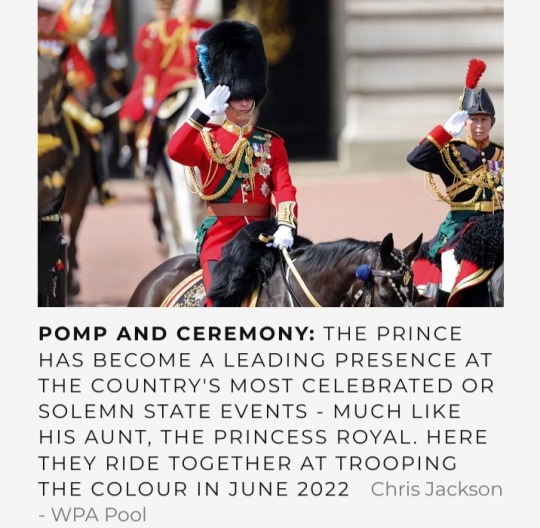
The Prince of Wales’s time has come to step up; and so he has deftly done.
In recent months, we have seen a fully-fledged deputy head of state putting into practice his long-held ideas, speaking out on the most contentious issue of the day and taking direct action on homelessness.
Last June, he unveiled the multi-agency Homewards initiative with the huge aspiration of ending homelessness, backed with £3 million from his Foundation to spearhead action across the UK.
He is consolidating Heads Together, the long-standing campaign on mental health, and fundraises for charities like London’s Air Ambulance Charity.
He was, of course, once a pilot for the East Anglian Air Ambulance services – a profession that had its downside: seeing people in extremis or at death’s door, he found himself ‘taking home people’s trauma, people’s sadness.’
Tom Cruise was a guest at the recent London’s Air Ambulance Charity fundraiser, William’s first gala event after Kate’s operation.
And more stardust followed when William showed that, even without his wife by his side, he could outclass any movie star at the Baftas.
There’s also his immense aim of helping to ‘repair the planet’ itself with his Earthshot Prize: five annual awards of £1 million for transformative environmental projects with worldwide application.
This project has a laser focus on biodiversity, better air quality, cleaner seas, reducing waste and combating climate change. Similar aims to his father; different means to achieve the goal.
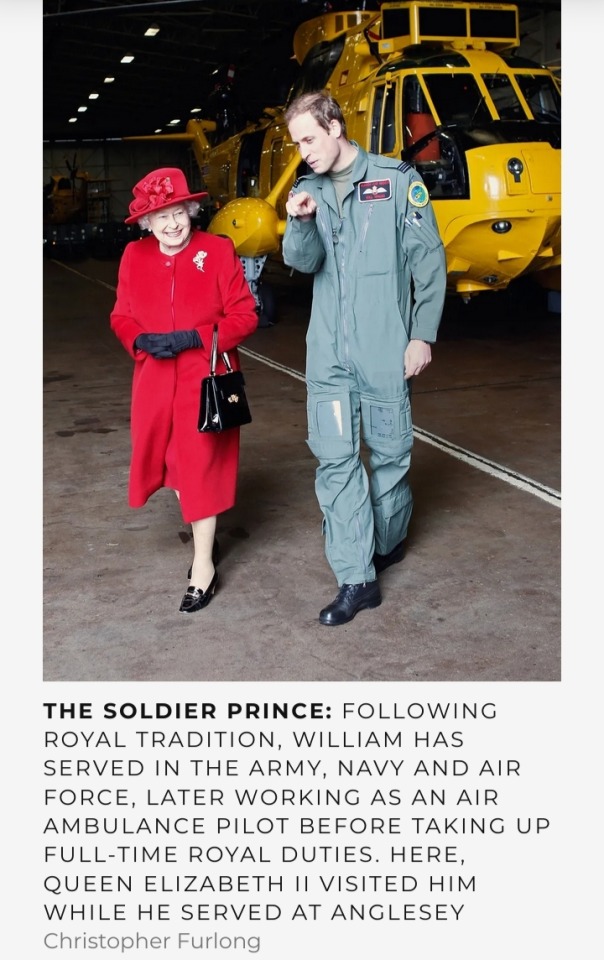
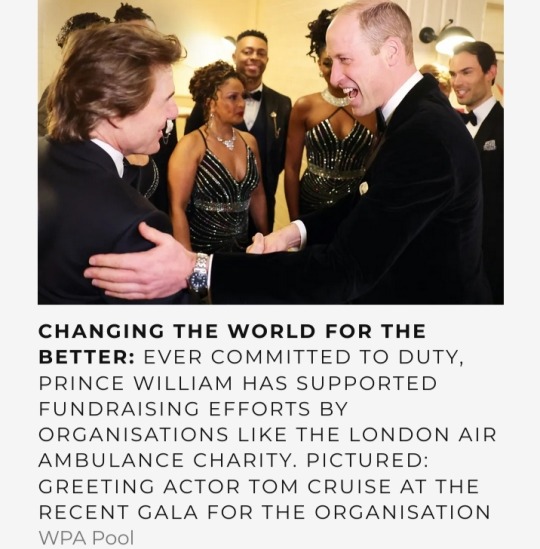
On the issue which has caused huge convulsions – the Middle East conflict – William’s 20 February statement from Kensington Palace grabbed attention.
He said he was ‘deeply concerned about the terrible human cost of the conflict since the Hamas terrorist attack on 7 October. Too many have been killed.’
There were criticisms – along the lines of ‘the late Queen would have never spoken out like this’ or ‘what right does he have to meddle in politics?’ – but it was hard to disagree with his carefully calibrated words.
His call for peace, the ‘desperate need’ for humanitarian aid, the return of the hostages.
The statement was approved by His Majesty’s Government, likely cleared with the King himself at Sandringham the previous weekend and also backed by the chief rabbi of Great Britain, Sir Ephraim Mirvis.
Indeed, William and Catherine had immediately spoken out on the horrors of 7 October.
William followed up the week after his Kensington Palace statement by visiting a synagogue and sending a ‘powerful message’, according to the chief rabbi, by meeting a Holocaust survivor and condemning anti-Semitism.
This is rooted in deep personal conviction following William’s 2018 visit to Israel and the West Bank, says Valentine Low, the distinguished author of Courtiers and The Times’s royal correspondent of 15 years, who was on that 2018 trip.
‘William was so moved by his visit to Israel and the West Bank, he found it very affecting, and he was not going to drop this issue – he was going to pay attention to it for the rest of his life,’ says Low.
‘He must feel that… not to say something on the most important issue in the world [at that moment] would be a bit odd if you feel so strongly about it.’
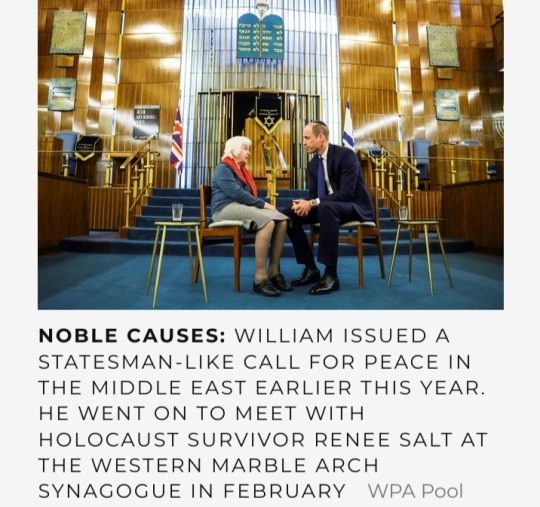
There was concern from some commentators about politicising the monarchy, but this rose above the particulars of party politics.
As Prince of Wales, like his father before him, there is perhaps space to speak out sparingly on carefully chosen issues.
On this occasion, his views were in line with majority public opinion.
On homelessness, news came that same week that William was planning to build 24 homes for the homeless on his Duchy of Cornwall estate.
‘William’s impact is very personal,’ says Mick Clarke, chief executive of The Passage, a charity providing emergency accommodation for London’s homeless.
‘Two weeks before Christmas, the prince came to our Resource Centre in Victoria for a Christmas lunch for 150 people.
He was scheduled to stay for an hour, to help serve, wash up, and talk to people.
He ended up staying for two and a quarter hours, during which time he went from table to table and spoke to every single person.’
Clarke continues:
‘William has an ability to listen, talk and to put people at ease. During the November 2020 lockdown, he came on three separate occasions to help.
It gave the team a boost that he took the time; it was his way of saying: “I support you; you’re doing a great job.”’
Seyi Obakin, chief executive of Centrepoint, one of the prince’s best-known causes, adds:
‘People associate his patronage with the big moments like the time he and I slept under Blackfriars Bridge.
The things that stick with me are smaller in scale and the more profound for it – in quieter moments, away from the cameras, where he has volunteered his time.’
It is a different approach from the King’s.
As Prince of Wales, he was involved in the minutiae of dozens of issues at any one time, working into the night to follow up on emails, crafting his speeches, writing or dictating notes.
Add to that much nationwide touring over 40 years (after he left active military service in 1976), fitting in multiple engagements, often being greeted formally by lord lieutenants.
This is not William’s style. He has commended his father’s model, but he does things his own way.
Although patronages are under review, William has up till now far fewer than either his father or his grandparents.

Charles is sympathetic to William’s approach and his desire to make time with his young family sacrosanct.
They are confidantes, attested by the night of Queen Elizabeth’s death.
They were both at Birkhall with Camilla, reviewing funeral arrangements while the rest of the grieving family were nearby at Balmoral, hosted by the Princess Royal.
Charles has had almost six decades in public life and is the senior statesman of our time, with even longer in the spotlight than Joe Biden.
After Eton and St Andrew’s University, where he met Catherine, William served in three branches of the military between 2006 and 2013, finishing as a seasoned and skilled helicopter rescue pilot.
His later employment as an air ambulance pilot stopped in 2017, when he became a full-time working royal.
At that time, not so long ago – with Harry unmarried, Andrew undisgraced, and Philip and Elizabeth still active – William shared the spotlight.
Now, after the King, he’s the key man.
He can look back on the success of his first big campaign initially launched with his wife and brother in 2016: Heads Together.
‘We are delighted that Prince William should have become such a positive and sympathetic advocate for mental health through his Heads Together initiative and now well-established text service, Shout, among other projects,’ says the longtime CEO and founder of Sane, the remarkable Marjorie Wallace CBE.
‘It is not always known that he follows in the footsteps of his father, the King, whose inspiration and vision were vital in the creation of our mental health charity Sane.
As founding patron, he was instrumental in establishing our 365-days-a-year helpline and was a remarkable and selfless support to me in setting up the Prince of Wales International Centre for Sane Research.’
'Indeed,' says Wallace, 'this is where Prince William echoes the work of his father, showing the same ‘understanding and compassion for people struggling through dark and difficult times of their lives and has done much to raise awareness and encourage those affected to speak out and seek help.
We owe a huge debt to His Majesty and the Prince of Wales for their involvement in this still-neglected area.’
Just as I saw all those years ago at that early solo engagement in Whitechapel, William still approaches his public duties with humour and fun.
‘He defuses the formality with jocularity,’ says Valentine Low, citing two public events in 2023 that he witnessed.
In April last year, while on a visit to Birmingham, William randomly answered the phone in an Indian restaurant he was being shown around and took a table booking from a customer – an endearing act of spontaneity.
On his arrival later that day, the unsuspecting diner was surprised to be told exactly whom he had been talking to.
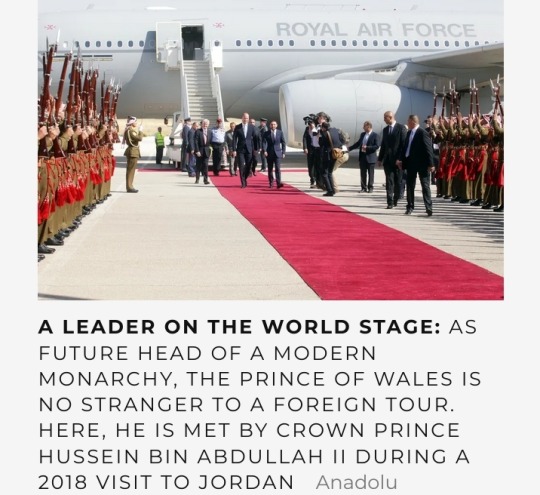
In October, Low reported, William ‘unleashed his inner flirt as he hugged his way through a visit with Caribbean elders [in Cardiff] to mark Black History Month.
As he gave one woman a hug – for longer than she expected – he joked: “I draw the line at kissing.”
And while posing for a group photograph, he prompted gales of laughter when he quipped: “Who is pinching my bottom?”’
Low believes that when William eventually becomes king, he will be more ‘radical’ than his father but wonders if people will respond to ‘call me William’ when ‘the whole point of the Royal Family is mystique and being different.’
However, William has thought deeply about his current role and is prepared for whatever his future holds.
For now, there is a decision to be made on Prince George’s secondary schooling. It’s said that five public schools are being considered, all fee-paying.
Eton is single-sex and boarding but close to home. Marlborough (Catherine’s alma mater) is co-ed and full boarding. And Oundle, St Edward’s Oxford and Bradfield College (close to Kate’s parents) are co-ed with a mix of boarding and day.
As parents, William and Catherine aspire to raise their children ‘as good people with the idea of service and duty to others as very important’, William said in an interview with the BBC in 2016.
‘Within our family unit, we are a normal family.’ Which may be one reason why he is so resistant to their privacy being compromised either by the media or close family members.
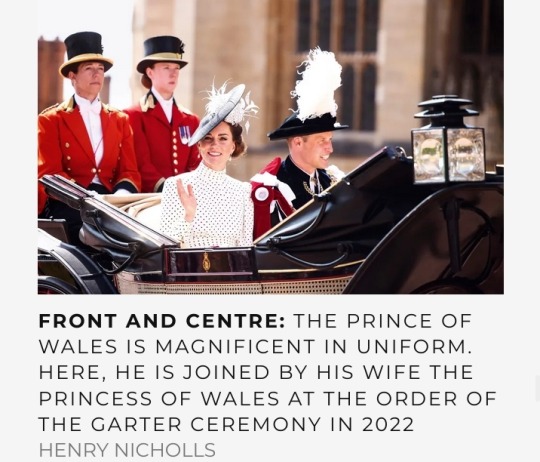
The 19th-century author Walter Bagehot wrote:
‘A family on the throne is an interesting idea also. It brings down the pride of sovereignty to the level of petty life… a princely marriage is the brilliant edition of a universal fact, and, as such, it rivets mankind.’
If hereditary monarchy is to survive, it must beguile us but also demonstrate its utility, that it is a force for good.
William said in that 2016 interview, ‘I’m going to get plenty of criticism over my lifetime,’ echoing Queen Elizabeth II’s famous Guildhall speech in 1992 ‘that criticism is good for people and institutions that are part of public life. No institution – city, monarchy, whatever – should expect to be free from the scrutiny of those who give it their loyalty and support, not to mention those who don’t.’
William saw close up his mother’s ability to bring public focus and her own personal magnetism to any subject or cause she focused on.
He admires his father’s work ethic, the way he ‘really digs down,’ sometimes literally (I understand that gardening is giving the King solace during his cancer treatment).
But the biggest influence for William was Her late Majesty, as he said on her 90th birthday.
As an Eton schoolboy, William made weekend visits to the big house on the hill, being mentored by Granny rather as she had been tutored in the Second World War by the then vice-provost of Eton, Sir Henry Marten.
William said in 2016:
‘In the Queen, I have an extraordinary example of somebody who’s done an enormous amount of good and she’s probably the best role model I could have.’
That said, his aim was ‘finding your own path but with very good examples and guidance around you to support you.'

Queen Elizabeth II had a brilliant way of rising above the fray and usually being either a step ahead of public opinion or in tune with it.
If you are at the helm of affairs in a privileged hereditary position, your duty is to serve and use your pulpit for the benefit of others.
In a democracy, monarchy is accountable.
The scrutiny is intense, with an army of commentators paid for wisdom and hot air about each no-show, parsing each announcement, interpreting each image.
William takes the long view. He has ‘wide horizons,’ says Mick Clarke.
‘There are so many causes that are more palatable and easier to achieve than ending homelessness, but his commitment and drive are 100 per cent.’
The prince seeks a different way of being royal in an ancient institution that must move with the times. His task? To develop something modern in an ever-changing world.
He faces all sorts of new issues – or old issues in new guises.
Noises off from within the family don’t help – Andrew’s difficulties, or the suggestions of prejudice from Montecito a couple of years ago (now seemingly withdrawn), which prompted William’s most vehement soundbite: ‘We’re very much not a racist family.’
William is maybe a new kind of leader who can keep the monarchy relevant and resonant in the coming decades.
Queen Elizabeth II is a powerful exemplar and memory, but she was of her time. William is his own man.
He must overcome and think beyond ‘the unforgiving minute.’
Indeed, he could seek inspiration in Rudyard Kipling’s poem, If.
If you can force your heart and nerve and sinew
To serve your turn long after they are gone,
And so hold on when there is nothing in you
Except the Will which says to them: ‘Hold on!’
If you can talk with crowds and keep your virtue,
Or walk with Kings—nor lose the common touch[…]
Yours is the Earth and everything that’s in it,
And—which is more—you’ll be a Man, my son!

This article was first published in the May 2024 issue, on sale Thursday, 28 March.
#Prince William#Prince of Wales#British Royal Family#Wesley Kerr OBE#Edward Longshanks#Homewards#Heads Together#London’s Air Ambulance Charity#East Anglian Air Ambulance#Tom Cruise#BAFTAS#Earthshot Prize#Kensington Palace#King Charles III#Sir Ephraim Mirvis#Valentine Low#Duchy of Cornwall estate#The Passage#Centrepoint#Birkhall#Sane#Marjorie Wallace CBE#Shout#Balmoral#Prince George#Walter Bagehot#Sir Henry Marten#Rudyard Kipling#If
150 notes
·
View notes
Text
They will come back - come back again, as long as the red Earth rolls.
He never wasted a leaf or a tree. Do you think He would squander souls?
#rudyard kipling#the sack of the gods#dead boy detectives#deaths poem dbda#dbda#rest in peace dead boy detectives#rip dbda#renew dead boy detectives#as long as the red earth rolls#george rexstrew#jayden revri#kassius nelson#yuyu kitamura#joshua colley#lukas gage#briana cuoco#jenn lyon#ruth connell#the sack of the gods rudyard Kipling
65 notes
·
View notes
Text
Credit: @dahtu on TikTok
Boots. Boots. Boots.
#naruto#naruto shippuden#naruto edit#naruto amv#anime amv#anime edit#naruto uzumaki#boots#rudyard kipling#itachi edit#itachi#sasuke edit#sasuke#kakashi hatake#boots boots boots
40 notes
·
View notes
Text
"Y hubo mil cosas que no elegí,
que me llegaron de pronto
y me transformaron la vida.
Cosas buenas y malas que no buscaba,
caminos por los que me perdí,
una vida que no esperaba.
Y elegí, al menos, cómo vivirla.
Elegí los sueños para decorarla,
la esperanza para sostenerla,
la valentía para afrontarla."
✍🏽Rudyard Kipling

#quotes#pienso en versos#frases#citas#vida#textos#escritores#literatura#rudyard kipling#inesperadas#valentía#libros
47 notes
·
View notes
Text

" Words are, of course, the most powerful drug used by mankind. "
- Rudyard Kipling
43 notes
·
View notes
Text
My Adventures with Superman Season 2 Easter Eggs
Welcome to another week of My Adventures with Superman! Oh man what a good ep and some fun easter eggs in this one too! Ok lets begin!
My Easter eggs lists for season 1 is here if you haven't seen it!
My season 2 episode 1 Easter eggs and references in My Adventures with Superman post is here
My season 2 episode 2 Easter eggs and references in My Adventures with Superman post is here
My season 2 episode 3 Easter eggs and references in My Adventures with Superman post is here
My Easter eggs and references in My Adventures with Superman comic issue 1 post is here
My season 2 episode 4 Easter eggs and references in My Adventures with Superman post is here
My season 2 episode 5 Easter eggs and references in My Adventures with Superman post is here
My season 2 episode 7 Easter eggs and references in My Adventures with Superman post is here
My Easter eggs and references for My Adventures with Superman comic issue 2 post is here
My season 2 episode 8 Easter eggs and references in My Adventures with Superman post is here
My season 2 episode 9 Easter eggs and references in My Adventures with Superman post is here
My season 2 episode 10 Easter eggs and references in My Adventures with Superman post is here
My Easter eggs and references for My Adventures with Superman comic issue 3 post is here
Spoilers if you haven't seen the episode
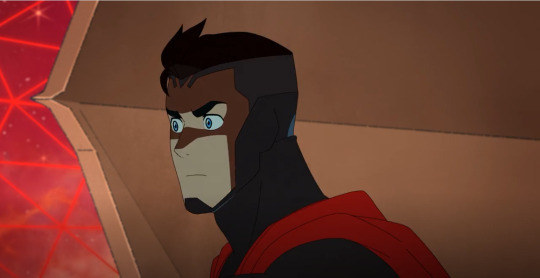
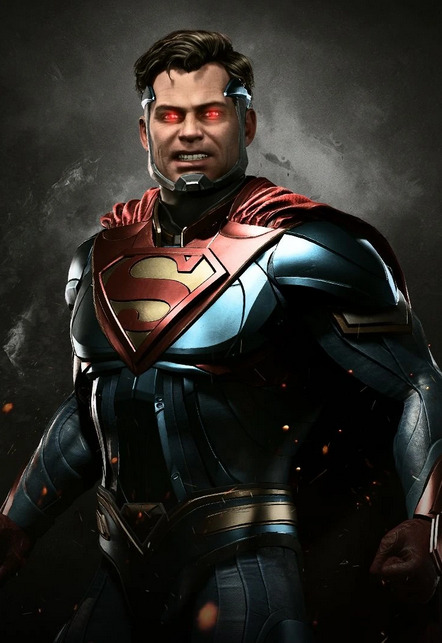
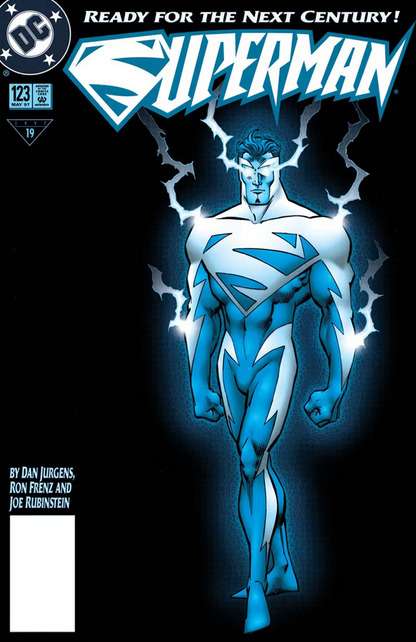
Ok so starting things off Superman wakes up from the capture coffin and is immediately like WTF Kara?! He tries to escape the ship he's on but needs a helmet to breathe in space and the suit grants him one. The way it looks really evokes either Injustice 2 Superman's default costume or his Electric Blue Superman look from the comics [Cover art of Superman #123 (1997), the glow in the dark variant cover, by Dan Jurgens, Joe Rubenstein, Patrick Martin, and Todd Klein].

The title of this week's ep is based on Rudyard Kipling's book, The Man Who Would Be King which is about two British adventurers who become kings in Kafiristan. Appropriate for the ep considering Brainiac who wants to flex his strength and might on other planets by sending Kara and his robots to level the entire civilization. How British colonizer of him. Fuck the colonizers.
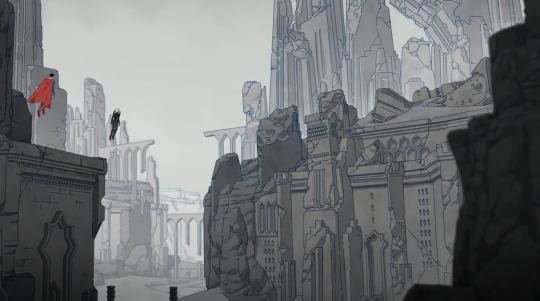
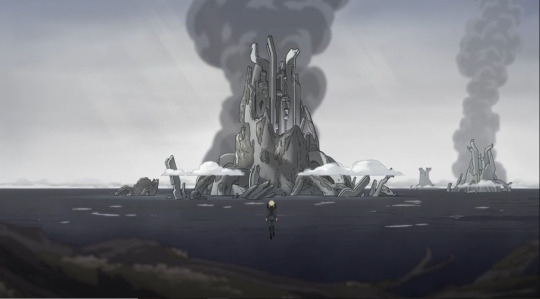
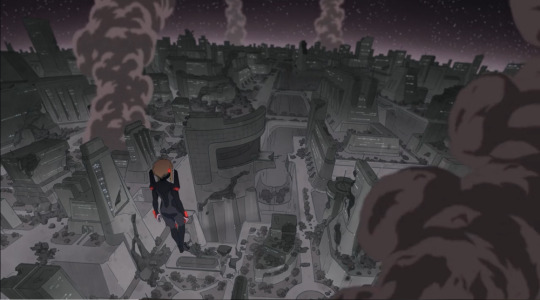
On Kara's ship, Clark tries to get to know her better and show her that Earth is cool, being kind and gentle is not a weakness, anything to get her away from the whole might makes rights idea and Kara name drops some locations Brainiac and her sacked after seeing some trinkets she stowed away on her ship. The locations are Thanagar, H'lven, and Euphorix. Clark asks Kara to take him to Thanagar where they see that its all just ruins. Later in the ep we learn why. The screenshots of the last two locations are from later on in the ep.
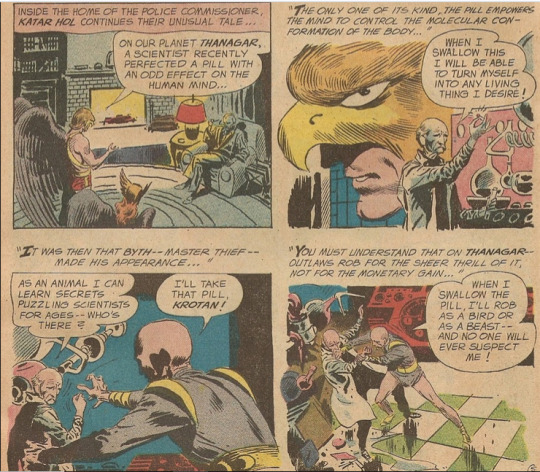
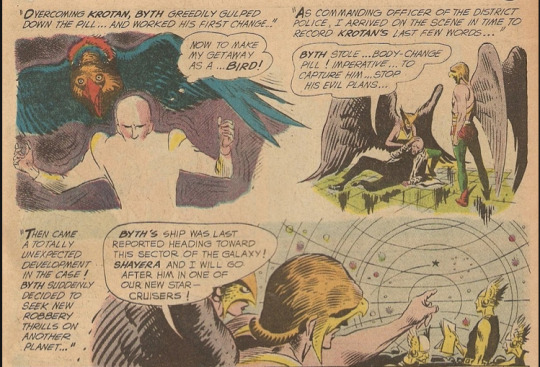
Thanagar makes its first appearance in The Brave and the Bold #34 (1961) [W: Gardner Fox, P&I: Joe Kubert, L: Gaspar Saladino] where Hawkman and Hawkwoman make their first appearance too. They are looking for the criminal Byth Rok. They meet Midway City's commissioner and tell him about their planet and people and explain who Byth Rok is and what he did. Later in the ep we do see a Thanagarian, but I doubt its Shayera/Hawkwoman cuz she would be using a Thanagarian mace not a polearm. Give the latest Hawkman series a read to explore more of not just Hawkman himself but also a look into Thanagar. Also read Batman: Universe if you want to see Batman get humbled by a Thanagarian guard because the guard assumed his cape was wings and Batman says "I can't fly, only glide with the cape" and the guard replies "ha, cute".
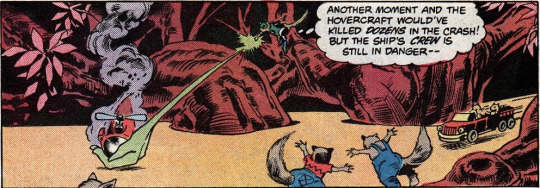
H'lven makes its first appearance in Green Lantern #148 (1982) [W: Paul Kupperberg, P: Don Newton, I: Dan Atkins, C: Anthony Tollins, L: John Costanza]. Its a heavily tree covered planet home to Ch'p and B'dg of the Green Lantern Corp (more on the GLC later). It's located in space sector 1014 where the inhabitants are all chipmunk/squirrel-like aliens. So yeah Brainiac destroyed a civilization of adorable anthropomorphic squirrels and chipmunks, what a piece of shit.

The final place Kara mentions and returns to later in the ep is Euphorix where its first appearance was in The Omega Men #2 [W: Roger Slifer (yes that Roger Slifer who Slifer the Sky Dragon from Yugioh was named after), Keith Giffen, P: Keith Giffen, I: Mike DeCarlo, C: Petra Scotese, L:John Costanza]. The silver planet you see in the panel there is one of the last free planets that has not been touched by the Citadel and it is where the Omega Men operate out of.
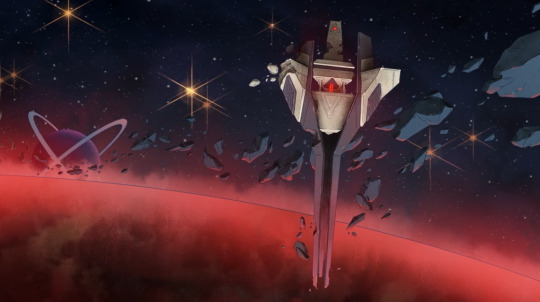
Kara and Clark have to cut their Thanagar visit short and she mentions that they must return to Kandor which if you know your DC universe is very different to the main satellite/mothership that Brainiac helms.
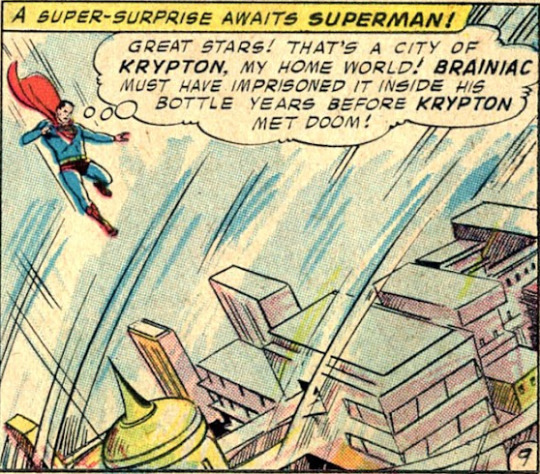
Unlike what MAwS did with Kandor so far, in the comics, Kandor was a bottled Kryptonian city for trading and commerce that Brainiac stole before Krypton's destruction. It's still populated too. It and Brainiac's first appearance was in Action Comics #242 (1958) [W: Otto Binder P&I: Al Plastino] where Superman was also shrunk down by Brainiac after he stole several cities on Earth and Superman finds Kandor and eventually rescues it. Most of the time the bottled city of Kandor is always seen located in the Fortress of Solitude or its been brought somewhere else to be enlarged to its normal state in different DC continuities. Very smart of the MAwS team to use the name as Brainiacs main transport to keep that Kandor-Brainiac connection and speaking of Brainiac...
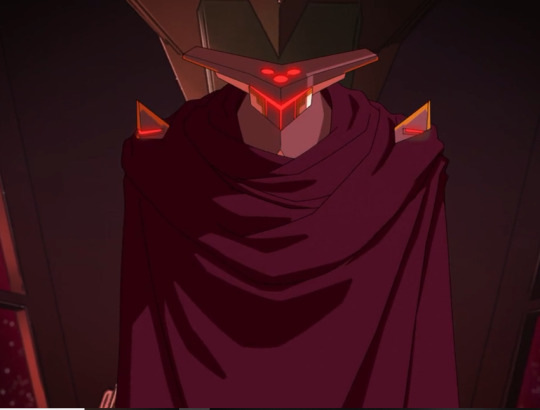
Brainiac is, as Kara designates him, Primus Brainiac who I talked more about here. Very smart of the MAwS crew to use the DCAU origins of Brainiac to really make it personal when it comes to Brainiac and Superman. Btw if you've never seen Superman the Animated Series, go watch it its fantastic. It and MAwS are my favorite adaptations of Superman.
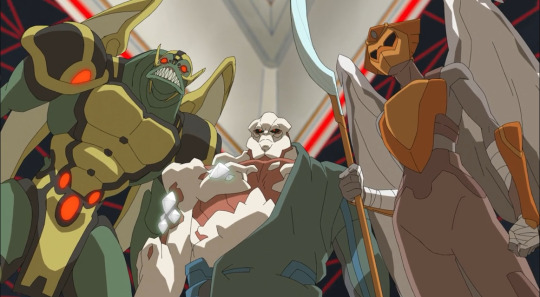
Brainiac takes Clark to his combat training chamber where we see a Parademon of Apokolips, a Green Lantern, and a Thanagarian who are just more robots taking on these projected forms of aliens that Brainiac has conquered or battled. I talked a bit about the Thanagarians already but...
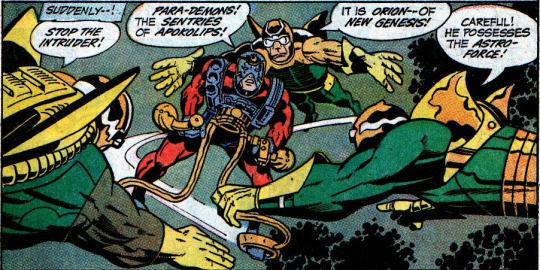
Parademons make their first appearance in The New Gods #1 (1971) [W&P: Jack Kirby, I: Vince Colleta, L: John Costanza] as the army troops for Darkseid. They're usually sent out in waves as an advancing force for whatever invasion Darkseid has plans and they swarm like crazy. The New 52 continuity makes them even more horrifying because Parademons are made from living or dead native species the planet the troops are invading and get genetically modified to be additional Parademons for Darkseids army.

As Clark fights the alien monk, we see that they wield a Green Lantern ring so we can presume they are from the Green Lantern Corp. The name Green Lantern was first used in All-American Comics #16 (1940) by Alan Scott who became Green Lantern and his ring was more mystical based compared to how everyone things of the Green Lantern Ring is now which is more sci-fi based.
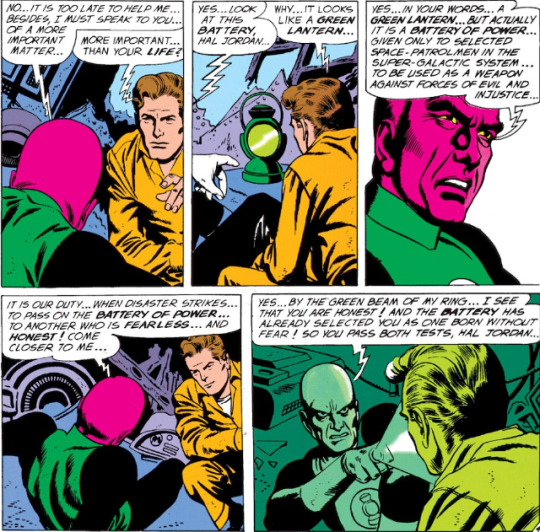
That Green Lantern was Hal Jordan who gained his ring from a dying Abin Sur who was the protector of space sector 2814, our solar system, and Abin Sur's ring chose Hal to take up the Green Lantern mantle. This is the Green Lantern that pop culture is more familiar with. Any time a Green Lantern Corp member dies, their ring will fly to another person who has the strongest willpower to be a Green Lantern. We can assume that alien monk has their ring fly somewhere to find a new worthy owner. Very cool that the MAwS crew were able to bring a Green Lantern ref in this ep! Also this is how I envision my War Forged monk that I use in DnD fights.

Clark gets swarmed by the robots after beating the three and we see that Brainiac also has a red sun emitter on his craft. I talked more about that Superman weakness here
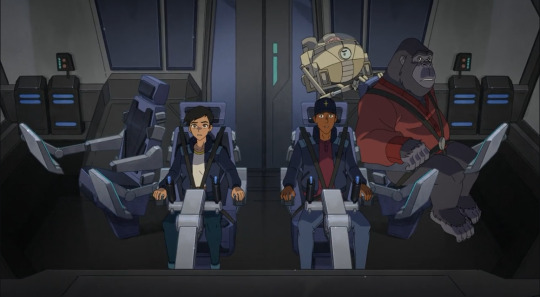
Kara discovers whats going on between Clark and Brainiac and after a chewing out, Kara goes into a trance like state and wakes up in an empty room. She finds her treasures from Thanagar, Euphorix, and H'lven and that wakes her up. She flies off to those planets again seeing them all in ruins and Thanagar shows that she caused all this. All alone and sad by this discovery in the emptiness of space, Kara sees a blue portal open up and its Lois, Jimmy, Mallah and the Brain from season 1 who I talked more about here and here.
And with that we are at the end. Come back next time to see how Lois and Jimmy meet up with Mallah and the Brain again!
My Easter eggs lists for season 1 is here if you haven't seen it!
My season 2 episode 1 Easter eggs and references in My Adventures with Superman post is here
My season 2 episode 2 Easter eggs and references in My Adventures with Superman post is here
My season 2 episode 3 Easter eggs and references in My Adventures with Superman post is here
My Easter eggs and references in My Adventures with Superman comic issue 1 post is here
My season 2 episode 4 Easter eggs and references in My Adventures with Superman post is here
My season 2 episode 5 Easter eggs and references in My Adventures with Superman post is here
My season 2 episode 7 Easter eggs and references in My Adventures with Superman post is here
My Easter eggs and references for My Adventures with Superman comic issue 2 post is here
My season 2 episode 8 Easter eggs and references in My Adventures with Superman post is here
My season 2 episode 9 Easter eggs and references in My Adventures with Superman post is here
My season 2 episode 10 Easter eggs and references in My Adventures with Superman post is here
My Easter eggs and references for My Adventures with Superman comic issue 3 post is here
#My Adventures with Superman#MAwS#My Adventures with Superman Season 2#MAwS season 2#Clark Kent#Superman#Lois Lane#Jimmy Olsen#Kara Kent#Kara Zor El#Supergirl#Brainiac#The Man Who Would Be King#Rudyard Kipling#Thanagar#Euphorix#H'lven#Kandor#The Bottled City of Kandor#Parademon#Parademons#Green Lantern#Green Lantern Corp#Green Lantern Ring#DC#DC Comics#DC Universe#Injustice 2#Electric Blue Superman
89 notes
·
View notes
Text
Everyone needs to watch this! It's so good! https://www.tiktok.com/t/ZT2CJhcmT/
#bucky barnes#winter soldier#captain america#captain america first avenger#captain america winter soldier#captain america civil war#james buchanan barnes#boots#poems#rudyard kipling#poem
24 notes
·
View notes